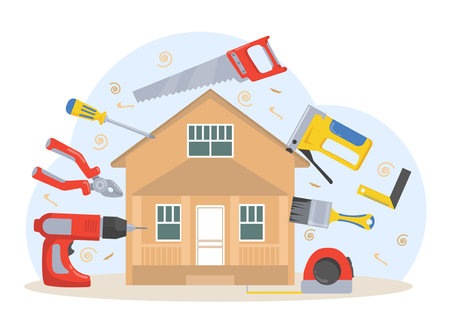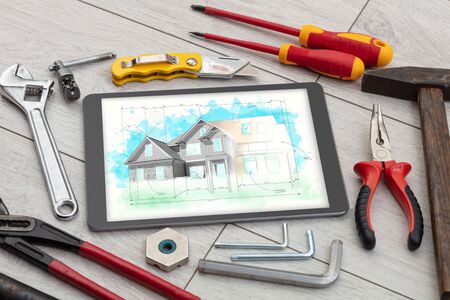1. Understanding Square Footage and Its Impact on Home Value
When it comes to buying or selling a home in the U.S., square footage is one of the first numbers people look at. But what exactly does it mean, and why is it so important? Let’s break down how square footage is measured and why it plays such a big role in home pricing.
How Square Footage Is Measured in the U.S.
In the United States, square footage refers to the total area inside a home that can be lived in. This usually includes:
- Bedrooms
- Living rooms
- Kitchens
- Bathrooms
- Other finished areas (like dens or offices)
Spaces like garages, unfinished basements, attics, or porches are typically not included in the official square footage count. The measurement is done by calculating the length and width of each room (in feet), then multiplying those numbers together and adding up all the rooms.
Example Table: Measuring Square Footage
| Room Name | Length (ft) | Width (ft) | Total Sq Ft |
|---|---|---|---|
| Living Room | 20 | 15 | 300 |
| Main Bedroom | 14 | 13 | 182 |
| Kitchen | 12 | 10 | 120 |
| Total Finished Sq Ft | 602 | ||
Why Square Footage Is a Key Factor in Pricing Homes
The price of a home is often calculated on a “price per square foot” basis. For example, if homes in your area are selling for $200 per square foot, and your house is 2,000 square feet, you might expect your home to be valued around $400,000. Larger homes generally cost more because they offer more living space.
Simplified Price Per Square Foot Example Table:
| Total Sq Ft | Price Per Sq Ft ($) | Total Home Price ($) |
|---|---|---|
| 1,500 | $220 | $330,000 |
| 2,000 | $220 | $440,000 |
| 2,500 | $220 | $550,000 |
How Buyers and Appraisers Use This Metric
Buyers: When house hunting, buyers often compare homes based on their size and price per square foot. This helps them understand if a property is priced fairly compared to similar homes in the neighborhood.
Appraisers: Appraisers use square footage as a major factor when determining the market value of a property. They will measure the home themselves to ensure accuracy and compare it with recent sales of similar-sized homes nearby.
The Bottom Line on Square Footage’s Role:
- Bigger homes usually cost more—but not always. Layout, upgrades, and location also matter.
- The official square footage only counts finished living spaces.
- This number helps everyone—buyers, sellers, agents, and lenders—get on the same page about a home’s value.
Understanding how square footage works gives you an edge whether you’re buying or selling a home. It’s one of the most straightforward ways to compare properties across any U.S. neighborhood.
2. How Upgrades and Renovations Affect Home Prices
Why Upgrades Matter in U.S. Home Pricing
In the American real estate market, upgrades and renovations can make a big difference in how much a home is worth. Buyers often look for move-in ready homes with modern features, so investing in the right improvements can help your property stand out and command a higher price.
Upgrades With the Best Return on Investment (ROI)
Not all renovations offer the same return. Some projects are more likely to boost your home’s value than others. Here’s a quick look at which upgrades typically offer the most bang for your buck:
| Upgrade Type | Average ROI (%) | Notes |
|---|---|---|
| Minor Kitchen Remodel | 70-80% | Refacing cabinets, new appliances, countertops |
| Bathroom Remodel | 60-70% | New fixtures, updated tile, improved lighting |
| Curb Appeal Improvements | 80-100% | Landscaping, painting, new front door |
| Finished Basement/Attic | 50-60% | Adds usable living space |
| Adding a Deck or Patio | 65-75% | Outdoor living is very popular in many regions |
| Energy-Efficient Windows/Doors | 60-75% | Lowers energy bills; appeals to eco-conscious buyers |
Popular Remodeling Trends in the U.S.
Certain trends are especially hot among American homeowners right now. Open-concept living spaces, smart home technology (like smart thermostats and security systems), and eco-friendly materials are all in demand. Updated kitchens with quartz countertops and stainless steel appliances, as well as spa-like bathrooms with walk-in showers and double vanities, tend to attract more buyers.
The Quality and Scope of Renovations Matter Too
The impact of a renovation on your homes price depends on both quality and scope. High-quality finishes, professional installation, and cohesive design choices usually add more value than DIY projects or mismatched updates. A full kitchen remodel will likely have more impact than just swapping out cabinet hardware, but sometimes simple changes like fresh paint or modern light fixtures can also make a noticeable difference.
Avoid Over-Improving for Your Neighborhood
It’s important to consider local market expectations when planning upgrades. If you put in high-end features that don’t match other homes nearby, you might not see a full return on your investment. Focus on improvements that align with what buyers in your area want and need.

3. Location, Location, Location: Why It Matters
When it comes to home pricing, location is often the most important factor of all. You might have a beautiful, upgraded home with plenty of square footage, but if it’s not in a great area, the price can still fall short of your expectations. Let’s break down why location matters so much in the U.S. real estate market and what buyers and sellers should pay attention to.
The Big Factors That Make Up “Location”
Location isn’t just about where a house sits on a map. It includes several key elements that directly affect how much someone is willing to pay for a home:
| Factor | Why It Matters |
|---|---|
| School Districts | Homes in top-rated school districts often sell for higher prices because many families prioritize their children’s education. |
| Walkability | Being able to walk to shops, parks, restaurants, or public transit increases a home’s appeal and value. |
| Amenities Nearby | Proximity to grocery stores, hospitals, gyms, entertainment venues, and more adds convenience and boosts property values. |
| Neighborhood Desirability | Safe streets, community feel, attractive landscaping, and well-maintained homes make an area more desirable and valuable. |
School Districts: A Top Priority for Many Buyers
In the U.S., school quality is one of the biggest reasons families choose certain neighborhoods. Homes located within highly rated school districts typically command a premium price—even if the house itself is similar to others just outside the district boundaries. For sellers, this can mean thousands or even tens of thousands of dollars difference in sale price.
Walkability and Convenience
The ability to easily walk to local shops, parks, or cafes is increasingly important in American cities and suburbs. Walkable neighborhoods tend to attract more buyers, especially young professionals and retirees who want easy access to daily essentials without always needing a car.
Amenities and Neighborhood Perks
Nearby amenities—like gyms, grocery stores, entertainment venues, or community centers—make life easier and more enjoyable. When these are close by, they can drive up demand (and prices) for homes in those areas.
What Makes a Neighborhood “Desirable”?
- Safety: Low crime rates are a must for most buyers.
- Curb Appeal: Well-kept lawns and attractive streets raise neighborhood status.
- Pride of Ownership: Neighborhoods where homeowners take care of their properties hold value better over time.
- Sense of Community: Friendly neighbors and local events can make an area feel like home.
The Bottom Line on Locations Impact on Price
No matter how stunning or upgraded a property is, its location will always play a major role in determining its value. Understanding what makes an area desirable—and how these factors affect pricing—can help you make smarter decisions whether you’re buying or selling a home.
4. Balancing Price Per Square Foot With Other Factors
When it comes to home pricing in the U.S., both buyers and realtors look beyond just the price per square foot. While this metric offers a quick way to compare homes, it doesn’t tell the whole story. Let’s break down how price per square foot is weighed against other important features like upgrades, curb appeal, and layout.
How Buyers and Realtors View Value
Most homebuyers start their search with a budget in mind. Price per square foot helps them compare different homes quickly. However, two houses with similar price per square foot can feel very different depending on their upgrades or location. Here’s what buyers often consider:
- Curb Appeal: A well-maintained front yard, fresh paint, and modern fixtures can make a strong first impression.
- Layout: An open floor plan or a functional room arrangement makes daily living easier and more enjoyable.
- Upgrades: New kitchens, bathrooms, floors, or smart home features add value beyond just size.
- Neighborhood: Proximity to good schools, shopping, and parks often outweighs raw square footage numbers.
Comparing Homes: Beyond the Numbers
| Factor | Description | Impact on Perceived Value |
|---|---|---|
| Price Per Square Foot | The cost of each square foot of living space | Good for basic comparison; may not reflect true livability or desirability |
| Curb Appeal | Visual attractiveness from the street | Makes a strong emotional impact; can justify higher prices |
| Layout | The flow and usability of rooms | A smart layout feels larger and more comfortable, boosting value even if square footage is lower |
| Upgrades & Renovations | Modern kitchens, baths, flooring, and fixtures | Buyers are often willing to pay more for updated spaces that save them future renovation costs |
| Location & Neighborhood | Nearby amenities, safety, school quality | A prime location can command top dollar regardless of home size or age |
The Big Picture in Home Pricing Decisions
Both buyers and realtors understand that while price per square foot matters, it’s only part of what makes a home valuable. Qualitative aspects like how a house looks from the street, how it feels inside, and where it’s located play huge roles in deciding whether a home is worth its asking price. In many cases, buyers are happy to pay a little more for a smaller home that feels right and is in the perfect spot.
5. How the Current Market Influences Home Pricing
When buying or selling a home in the U.S., it’s not just about the square footage, recent upgrades, or where the house is located. The broader real estate market plays a huge role in shaping how much homes are worth and what kind of price you can expect. Here’s how key factors like market trends, interest rates, and inventory impact home pricing across different regions.
Market Trends: Sellers vs. Buyers Market
The balance between buyers and sellers changes all the time. In a seller’s market—when there aren’t enough homes for sale—prices tend to go up, and sellers have more power to set higher prices. In a buyer’s market—where there are plenty of homes but not as many buyers—prices might drop, and buyers can negotiate better deals.
| Market Type | What It Means for Pricing |
|---|---|
| Sellers Market | Higher home prices, bidding wars, faster sales |
| Buyers Market | Lower prices, more room for negotiation, longer time on market |
Interest Rates: Impact on Affordability
Interest rates directly affect how much buyers can afford. When rates are low, monthly mortgage payments are lower, so more people can buy homes—even at higher prices. When rates climb, affordability drops, which can slow down price growth or even cause prices to dip in some areas.
Example: Monthly Payments at Different Interest Rates
| Home Price | Interest Rate | Estimated Monthly Payment* |
|---|---|---|
| $400,000 | 4% | $1,910 |
| $400,000 | 6% | $2,398 |
*Approximate payment for principal and interest; actual payments vary based on loan terms.
Inventory Levels: Supply Shapes Demand
The number of homes available (inventory) also affects pricing strategies. If there are only a few homes for sale in your area (low inventory), sellers can ask for higher prices. But if many similar homes are on the market (high inventory), competition drives prices down or keeps them stable.
Diverse U.S. Regions: Local Differences Matter
The impact of these factors isn’t the same everywhere. For example:
- West Coast: High demand and limited space often mean higher prices even when interest rates rise.
- Southeast: Fast-growing cities may see big price jumps when inventory is tight.
- Midwest: More balanced markets with slower price changes.
- Northeast: Older homes and varied upgrades can make pricing less predictable.
How Sellers Adjust Their Strategies by Region
| Region | Sellers’ Typical Strategy When Market Changes |
|---|---|
| West Coast (e.g., California) | Add value with smart upgrades to stand out; price aggressively when inventory is low. |
| Southeast (e.g., Florida) | Highlight new features and competitive pricing to attract out-of-state buyers. |
| Midwest (e.g., Ohio) | Focus on affordability and practical upgrades; keep pricing steady unless demand spikes. |
| Northeast (e.g., New York) | Emphasize location benefits; adjust pricing for property age and unique features. |
Overall, keeping an eye on current market conditions helps both buyers and sellers make smarter decisions about home pricing—no matter where they live in the U.S.
6. Tips for Buyers and Sellers to Maximize Value
For Buyers: How to Get the Best Deal
When shopping for a home, square footage, upgrades, and location are key factors that affect pricing. Here’s how you can use this knowledge to your advantage:
Know What Youre Paying For
- Square Footage: Compare price per square foot in your target neighborhood. This helps you see if a home is priced fairly.
- Upgrades: Look for recent renovations like new kitchens or bathrooms. Ask for receipts or permits to verify work was done professionally.
- Location: Research local amenities, schools, crime rates, and commute times. Sometimes a slightly higher price is worth it for a better location.
Negotiation Tips
- Don’t Skip the Inspection: Use inspection results to negotiate repairs or a lower price if needed.
- Be Ready to Walk Away: There are always other homes. Don’t overpay just because you’re emotionally invested.
Quick Checklist for Buyers
| Factor | What to Check |
|---|---|
| Square Footage | Compare with similar homes nearby |
| Upgrades | Quality and recency of improvements |
| Location | Amenities, schools, safety, commute |
| Inspection | No hidden issues or needed repairs |
For Sellers: Boosting Your Home’s Appeal and Value
If you’re planning to sell, focusing on square footage, upgrades, and your home’s location can help you get the best price.
Add Value Where It Counts
- Highlight Square Footage: Make rooms feel bigger by decluttering and using light paint colors.
- Smart Upgrades: Kitchens and bathrooms offer the highest return on investment in most U.S. markets. Consider modern fixtures or energy-efficient appliances.
- Curb Appeal Matters: First impressions count—tidy up landscaping and add fresh exterior paint if needed.
- Market Location Benefits: Mention local attractions, good schools, and convenient transportation in your listing.
Top Home Improvements by ROI (Return on Investment)
| Upgrade Type | Estimated ROI (%) |
|---|---|
| Minor Kitchen Remodel | 70-80% |
| Bathroom Upgrade | 60-70% |
| Curb Appeal Enhancements (Landscaping/Paint) | 75-100% |
| Add Energy-Efficient Windows/Doors | 60-80% |
Your Next Steps as a Buyer or Seller
No matter which side of the transaction you’re on, understanding how square footage, upgrades, and location impact price puts you in control. Do your research, focus on what buyers value most, and use these tips to make smart decisions that maximize your investment.


